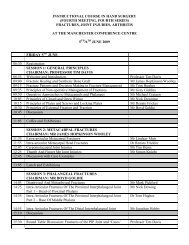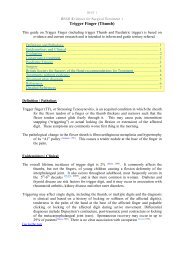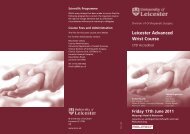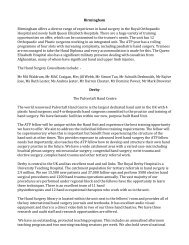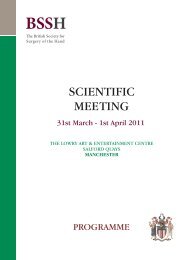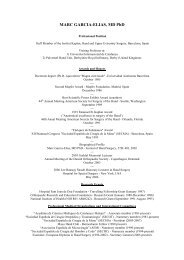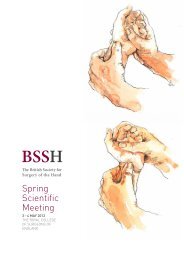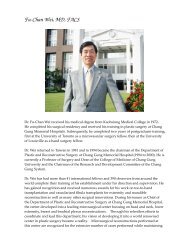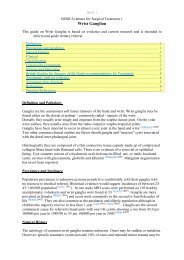here - The British Society for Surgery of the Hand
here - The British Society for Surgery of the Hand
here - The British Society for Surgery of the Hand
You also want an ePaper? Increase the reach of your titles
YUMPU automatically turns print PDFs into web optimized ePapers that Google loves.
THURSDAY, 1 MAY<br />
09:00 Refreshments and Registration<br />
09:30 Welcome by <strong>the</strong> President<br />
FREE PAPERS – DUPUYTREN’S CONTRACTURE<br />
CHAIRMAN: MR N D DOWNING/MR M K SOOD<br />
09:35 <strong>The</strong> Science <strong>of</strong> Dupuytren’s Disease: <strong>The</strong> Current State<br />
Pr<strong>of</strong>essor D A McGrou<strong>the</strong>r (Manchester)<br />
09:50 Assessment and Recording <strong>of</strong> Dupuytren’s Contracture<br />
Mr D Warwick, Mr A Mohan (Southampton)<br />
10:00 Recurrence and Complication Rates following First Revision Fasciectomy <strong>for</strong> Dupuytren’s Contracture<br />
Mr P Kanapathipillai, Mr R Nanda, Mr S Gupta, Pr<strong>of</strong>essor J Stothard, Mr A Middleton (Middlesbrough)<br />
Introduction: Recurrence rates <strong>of</strong> flexion contracture are high in Dupuytren’s disease. A significant<br />
proportion <strong>of</strong> patients will require revision surgery. We aimed to assess outcome and factors predictive <strong>of</strong><br />
outcome in patients having <strong>the</strong>ir first revision fasciectomy.<br />
Methods: All first revision fasciectomies over a five-year period (2001-5) were identified. Pre- and postoperative<br />
flexion contractures and complications were analysed on <strong>for</strong>ty-three operated fingers (average<br />
follow-up 14.8 months). All patients were sent <strong>the</strong> validated BSSH postal questionnaire assessing surgical<br />
outcome and fur<strong>the</strong>r analysis was possible on twenty-four <strong>of</strong> <strong>the</strong>se operated fingers (average follow-up<br />
47.2 months).<br />
Results: MCPJ: <strong>The</strong> average pre-operative contracture <strong>of</strong> 44° was corrected by 91% to 5° at 14.8 months.<br />
Half <strong>of</strong> MCPJs that were fully corrected at <strong>the</strong> time <strong>of</strong> surgery remained corrected at three years.<br />
PIPJ: <strong>The</strong> average pre-operative contracture <strong>of</strong> 63° was corrected by 68% to 20° at 14.8 months. 62% <strong>of</strong><br />
fully corrected PIPJs had some level <strong>of</strong> recurrence at three years (20% being worse than <strong>the</strong> original preoperative<br />
contracture). Operating on PIPJs with pre-operative flexion contractures <strong>of</strong> greater than 60°<br />
significantly increased <strong>the</strong> risk <strong>of</strong> recurrence.<br />
We did not find that full thickness skin grafting at <strong>the</strong> level <strong>of</strong> PIPJ (24 out <strong>of</strong> 31) or complete on-table<br />
correction significantly reduced <strong>the</strong> rate <strong>of</strong> contracture recurrence after three years. Complications occurred<br />
in 40% <strong>of</strong> patients, <strong>the</strong> commonest being infection (20%) followed by neuropraxia (16%).<br />
Discussion: Patients can be more accurately counselled prior to operation <strong>for</strong> first revision fasciectomy<br />
with regards to both recurrence and complication rates.<br />
10:10 Securing Full Thickness Grafts in <strong>the</strong> <strong>Hand</strong>: Don’t be Afraid to Quilt!<br />
Mr M A Akhavani, Mr T Mackinnell, Mr N Kang (London)<br />
Introduction: A skin graft is <strong>the</strong> simplest way to reconstruct an area <strong>of</strong> skin loss. To improve <strong>the</strong> chance<br />
<strong>of</strong> successful take, shearing <strong>for</strong>ces and haematoma <strong>for</strong>mation between <strong>the</strong> bed and <strong>the</strong> graft must be<br />
reduced. To achieve this, many surgeons use a tie-over dressing to secure <strong>the</strong> graft. However, “quilting”<br />
<strong>the</strong> graft to <strong>the</strong> wound bed is an alternative method <strong>for</strong> securing grafts which may be superior to tie-over<br />
dressings. <strong>The</strong> purpose <strong>of</strong> this study was to compare <strong>the</strong> outcome <strong>of</strong> securing full thickness grafts by tieover<br />
dressing versus quilting in <strong>the</strong> hand.<br />
Materials and Method: A retrospective study was per<strong>for</strong>med comparing <strong>the</strong> outcome <strong>of</strong> a tie-over dressing<br />
versus quilting to secure FTSG in a series <strong>of</strong> patients undergoing derm<strong>of</strong>asciectomy by a single surgeon.<br />
A total <strong>of</strong> <strong>for</strong>ty case notes were studied, with 20 patients in each group.<br />
Results and Statistics: Amongst <strong>the</strong> <strong>for</strong>ty patients, t<strong>here</strong> was only one complete and one partial graft<br />
failure – both due to haematoma in <strong>the</strong> tie-over dressing group. <strong>The</strong> grafts secured by quilting had a 100%<br />
graft take. T<strong>here</strong> were no o<strong>the</strong>r recorded complications or adverse outcomes.<br />
2



